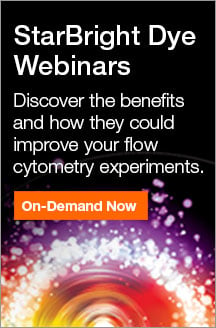StarBright Stain Index
Fluorescent dyes can have similar maximal excitation and emission wavelengths but may have differing brightness. Bright fluorescent dyes are preferred for low abundance markers and rare events, while dimmer dyes are preferred for high abundance markers. In panel design, knowing the relative brightness of all your dyes will help improve your panel design, make analysis easier, and enable you to build bigger, better panels.
This page provides a handy reference guide when choosing a fluorescent dye for your experiment. We have calculated the stain index of our new StarBright™ Dyes and other commonly used dyes in flow cytometry on the ZE5 Cell Analyzer to help you choose the right dyes for your experiments.
355 nm Ultraviolet Excitable Dyes
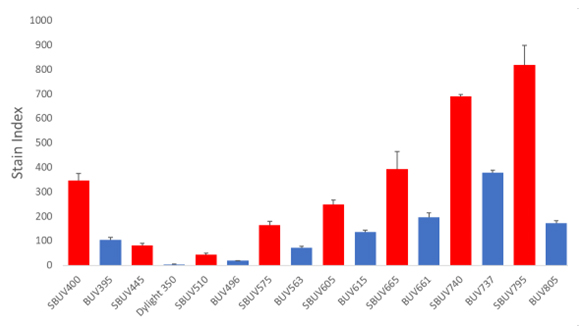
Fig 1. Stain index comparison of various 355 nm excitable dyes used to detect CD4 in human peripheral blood samples. StarBright UltraViolet Dyes (red), Brilliant Ultraviolet, and conventional dyes (blue) were conjugated to Mouse Anti Human CD4 (MCA1267). Data shown are the average of three donors. Antibodies were titrated prior to use and analyzed on the ZE5 Cell Analyzer. BUV, Brilliant Ultraviolet; SBUV, StarBright UltraViolet Dye.
405 nm Violet Excitable Dyes
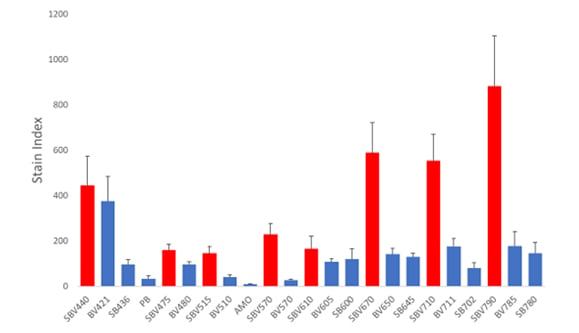
Fig 2. Stain index comparison of various 405 nm excitable dyes used to detect CD4 in human peripheral blood samples. StarBright Violet Dyes (red), Brilliant Violet, and conventional dyes (blue) were conjugated to Mouse Anti Human CD4 (MCA1267). Data shown are the average of three donors. Antibodies were titrated prior to use and analyzed on the ZE5 Cell Analyzer. BV, Brilliant Violet; SB, Super Bright; PB, Pacific Blue; AMO, Amethyst Orange; SBV, StarBright Violet Dye.
488 nm Blue Excitable Dyes
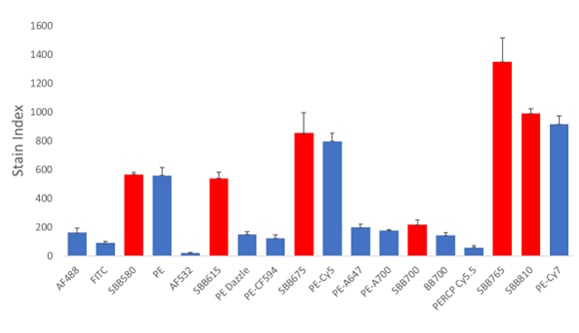
Fig 3. Stain index comparison of various 488 nm excitable dyes used to detect CD4 in human peripheral blood samples. StarBright Blue Dyes (red), Brilliant Blue, and conventional dyes (blue) were conjugated to Mouse Anti Human CD4 (MCA1267). Data shown are the average of three donors. Antibodies were titrated prior to use and analyzed on the ZE5 Cell Analyzer. AF, Alexa Fluor; BB, Brilliant Blue; Cy, cyanine dye; PE, phycoerythrin; SBB, StarBright Blue Dye.
561 nm Yellow Excitable Dyes
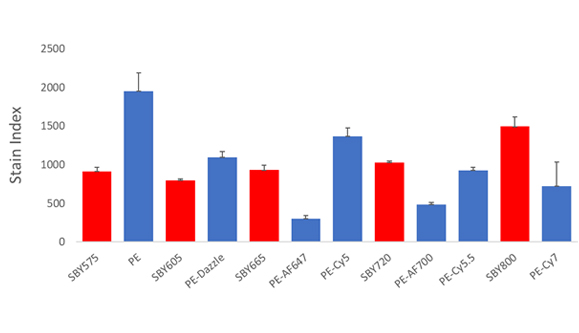
Fig 4. Stain index comparison of various 561 nm excitable dyes used to detect CD4 in human peripheral blood samples. StarBright Yellow Dyes (red) and PE and PE tandem dyes (blue) were conjugated to Mouse Anti Human CD4 (MCA1267). Data shown are the average of three donors. Antibodies were titrated prior to use and analyzed on the ZE5 Cell Analyzer. PE, phycoerythrin; Cy, cyanine dye; AF, Alexa Fluor; SBY, StarBright Yellow Dye.
Many factors can influence the appearance of data. This can be the flow cytometer, filters and laser used to excite the fluorophore, the laser power, and instrument settings as well as the type of plot chosen. For this reason, we recommend using this data as a guide only and calculating the stain index on your own instrument.
For more information about fluorophores and immunophenotyping, refer to our flow cytometry resources. Click on the links below to find more in-depth information on each topic and view our popular flow cytometry basics guide.

